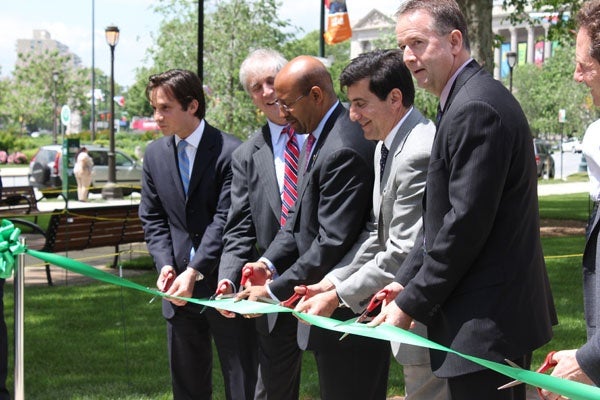When is a revitalization project too ambitious?

Mayor Michael Nutter (center) cuts the ribbon on Sister Cities Park. (Emma Jacobs/WHYY)
History has shown us that it’s not easy for one project, or even one neighborhood, to solve a city’s problems.
Revitalization can mean a lot of things. To some people, it means creating public spaces, like parks and bike trails, and improving quality of life. To others, it’s about economic development, and a city’s fiscal health.
Sometimes, cities launch a single project — maybe a casino, a sports venue, or an arts center — that’s supposed to serve all of those purposes. That rarely works.
Think of it this way: if you buy a product that purports to do more than one thing really well, does it ever deliver? I’m talking about the 3-in-1 shampoo, conditioner, and bodywash. (Might as well use a bar of soap.) Or the regional food places that serve Chinese, Japanese and Thai food (and you’re telling me it all tastes authentic?). Products and establishments that “do it all” usually don’t do it all well.
Maybe it’s like that with development, too.
Landscape architect Bryan Hanes designs public spaces for the city of Philadelphia, including Sister Cities Garden. In a Q&A with Philly Mag, Hanes said that when he designs a public space, he’s thinking primarily about community interaction, not economic development or saving the environment.
“If a public space can contribute economically to the city, that’s great,” Hanes told Philly Mag. “If we can contribute to a better ecology, that’s huge. But probably more than anything, we’re looking for ways to engage people and to create social environments … like a living room where people can come together.”
Focusing on one purpose per project could be a good strategy. Philadelphia has invested in other sites designed to create jobs and boost local businesses, like the Philadelphia Navy Yard and the city’s new Comcast building. The city doesn’t necessarily need its public parks to help the economy, too.
History has shown us that it’s not easy for one project, or even one neighborhood, to solve a city’s problems.
In 2006, Harrah’s built a casino in Chester, taking advantage of the state’s Keystone Opportunity Zone program. The KOZ program gives companies tax breaks for developing vacant or contaminated land.
The city hoped the casino would create jobs for residents, spur spinoff development and boost the city’s finances. Eight years later, most of the jobs at the casino have gone to people who live outside of Chester, and the only spinoff development has happened on the waterfront itself, which is far removed from the city’s downtown.
The casino does provide the city a significant amount of revenue; as of 2011, Chester relied on the casino for about 30 percent of its operating revenue. That funding is in question as Harrah’s struggles to compete with other Pennsylvania casinos.
There might be a middle ground. The city of Allentown has one major project: a generous tax incentive zone that allows developers to use state tax dollars to finance construction. The city administration hopes the development, particularly the new arena PPL Center, will also lead to jobs for locals.
But the city’s tax incentive zone is multi-faceted; it’s not just about one new building that is expected to spark a comeback. It’s a several-block area that will include public space, recreation, and yes, hopefully create jobs and make the city a destination.
Meanwhile, Philadelphia will keep plugging away with its own revitalization projects. Philly Mag has a feature on the topic this week, including a section about public spaces and a look at the projects that are changing West Philadelphia.
WHYY is your source for fact-based, in-depth journalism and information. As a nonprofit organization, we rely on financial support from readers like you. Please give today.


